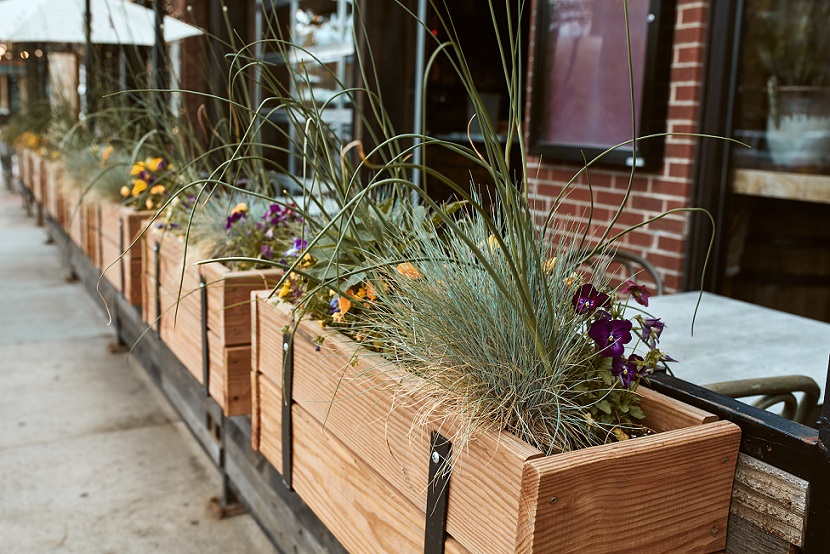
Wooden planters and raised garden beds bring a natural, rustic charm to outdoor spaces—but over time, they take a beating. Between dirt, water, sun exposure, mildew, and plant debris, wood can begin to gray, crack, or grow moldy. The good news? Power washing can restore their appearance and extend their life when done properly 💦🌿.
In this article, we’ll explore how to safely power wash wooden planters and garden beds, what precautions to take, and how to protect the wood afterward for long-lasting results.
🌱 Why Wooden Planters Get So Grimy
Outdoor planters are constantly exposed to the elements. Some of the most common problems include:
- Dirt buildup from rain splatter or garden tools
- Algae and mold from consistent moisture
- Sun fading that turns wood gray or dull
- Soil stains that leave rings or dark patches
- Insect nests or spider webs in corners and cracks
Left untreated, these issues can cause deterioration or rot. Regular cleaning helps prevent damage and keeps your garden looking fresh and tidy 🌼.
🚿 Can You Power Wash Wooden Planters?
Yes—but with caution. Unlike concrete or metal, wood is soft and porous. High-pressure water can splinter the surface, strip protective coatings, or gouge the grain.
✅ Use power washing for:
- Cedar, redwood, or pressure-treated planters
- Raised beds with weathered exterior wood
- Outdoor wood furniture sets and trim
❌ Avoid power washing:
- Old or brittle wood that’s beginning to rot
- Painted or sealed surfaces you want to preserve
- Wooden structures with structural cracks or separation
Browse Amazon Here For Top Rated Power Washers And Accessories
🧼 Step-by-Step Guide to Power Washing Planters
Here’s how to safely clean your wooden garden accessories with a pressure washer:
1. Remove Soil and Plants
Take out any soil, mulch, plants, or liners from the planter. This prevents water from splashing dirt back onto the surface and avoids saturating the soil.
2. Inspect for Rot or Weakness
Before cleaning, check for soft spots or splintered boards. If any part of the planter is rotting or separating, replace it before continuing.
3. Use a Low-Pressure Setting
Set your pressure washer to 1,000–1,200 PSI max. Use a 25- or 40-degree fan nozzle to spread the water out more evenly and reduce direct force.
4. Pre-Soak the Wood
Before applying soap, rinse the surface with water. This helps prevent soap from soaking in too quickly and reduces the chance of blotching.
5. Apply a Wood-Safe Detergent
Use a biodegradable, wood-safe cleaner. Apply it using the washer’s detergent tank or a garden sprayer. Let it sit for 5–10 minutes.
Browse Amazon Here For Wood-Safe Pressure Washing Cleaners
6. Rinse Using Smooth, Even Passes
Hold the nozzle at least 12 inches from the surface. Spray in the direction of the wood grain, not against it, to avoid damage.
7. Let It Dry Completely
Allow the wood to air-dry for 24–48 hours before using or resealing it. Avoid stacking or storing planters while they’re wet.
🧴 Optional: Brighten or Re-Stain the Wood
After cleaning, the wood may look lighter—but it can also appear blotchy. If desired, you can apply:
- A wood brightener to restore uniform color
- A clear sealant for moisture protection
- A natural oil (like linseed or tung) to rejuvenate and protect
- An outdoor wood stain if you want to change the color
Re-sealing the wood is highly recommended—especially if your planters or beds are in direct sun or heavy rain zones ☀️🌧️.
🪴 Safety Tips for Garden Beds
If you’re working with garden beds used for growing food, avoid using harsh chemicals during power washing. Here’s how to stay safe:
- Use vinegar or plant-safe soaps
- Rinse extra thoroughly
- Let the wood dry completely before refilling with soil
- Line the inside with non-toxic landscape fabric if needed
Avoiding toxic residues ensures your vegetables and herbs stay safe for consumption 🥕🌿.
🧠 Pro Tips for Long-Term Maintenance
To get the most out of your wooden garden features:
- Clean them once or twice per year
- Seal or oil the wood every 1–2 years depending on sun exposure
- Raise the beds slightly off the ground using bricks or gravel to avoid rot
- Keep vines or weeds from climbing up and trapping moisture
- Store smaller planters indoors during winter if possible
Taking care of your wood helps it stay sturdy and attractive for many growing seasons 🌼🧽.
✅ Final Thoughts: Power Washing for a Greener Garden
Power washing is a simple yet powerful way to bring your wooden planters and beds back to life. With the right settings, technique, and aftercare, you can strip away years of grime and give your garden a clean, polished look—without damaging the structure.
So grab that pressure washer and show your raised beds some love—they deserve it! 🌻🪵💦
Browse Amazon Here For Popular Pressure Washers And Accessories



